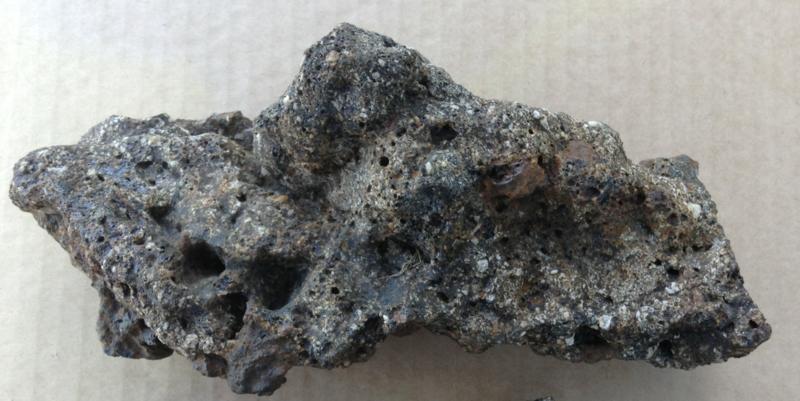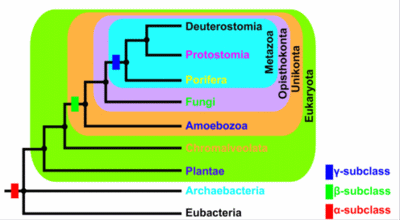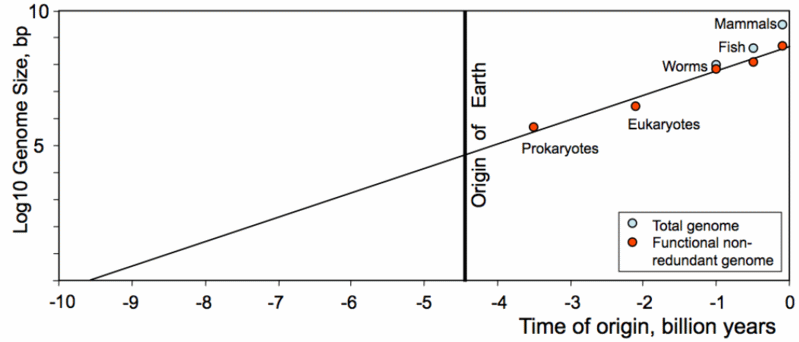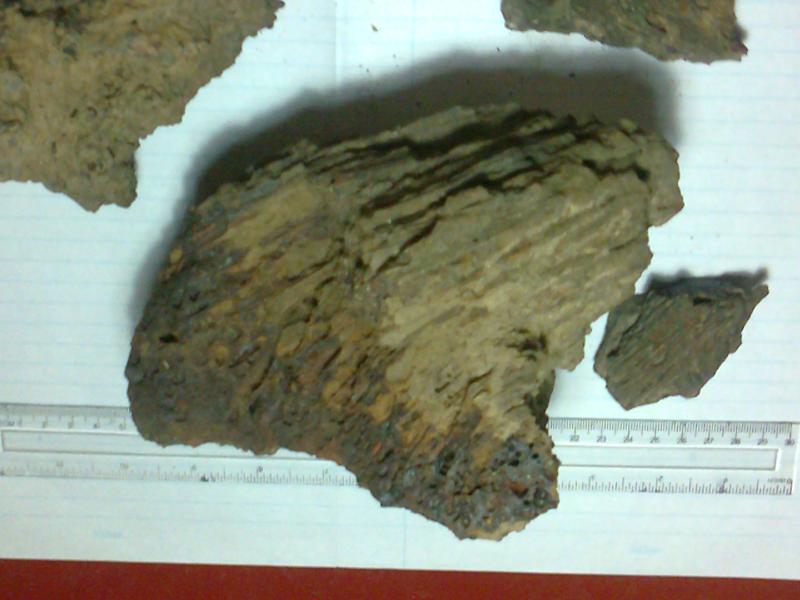What'sNEW April - June 2013
 Correspondence with Michael Behe illuminates some differences between ID and CA. Correspondence with Michael Behe illuminates some differences between ID and CA.
 Mars had an oxygen-rich atmosphere long before Earth did, and the red planet's color comes from iron rusted in the presence of oxygen, according to Oxford University geochemists. Interestingly, Earth also was a red planet for a time, when cyanobacteria began releasing oxygen and the exposed iron rusted here. Perhaps life on Mars created a similar environment but died out (dried out?) soon after.
Mars had an oxygen-rich atmosphere long before Earth did, and the red planet's color comes from iron rusted in the presence of oxygen, according to Oxford University geochemists. Interestingly, Earth also was a red planet for a time, when cyanobacteria began releasing oxygen and the exposed iron rusted here. Perhaps life on Mars created a similar environment but died out (dried out?) soon after.
 J. Tuff, J. Wade & B. J. Wood, "Volcanism on Mars controlled by early oxidation of the upper mantle"
[abstract], doi:10.1038/nature12225, p342-345 v498, Nature, 20 Jun 2013. J. Tuff, J. Wade & B. J. Wood, "Volcanism on Mars controlled by early oxidation of the upper mantle"
[abstract], doi:10.1038/nature12225, p342-345 v498, Nature, 20 Jun 2013.
 Mars had oxygen-rich atmosphere 4000m years ago, University of Oxford (+PhysOrg.com +BBC News), 19-20 Jun 2013. Mars had oxygen-rich atmosphere 4000m years ago, University of Oxford (+PhysOrg.com +BBC News), 19-20 Jun 2013.
 Life on Mars! and Life on Mars! and  Gaia are related local webpages. Gaia are related local webpages.
 Thanks for an alert, Stan Franklin. Thanks for an alert, Stan Franklin.
 Bob Dyer replies with comments, 22 Jun 2013. Bob Dyer replies with comments, 22 Jun 2013.
It is surprising to have large, potentially complex fossils that far back — Christopher H. House, Penn State University
 3 billion-year-old microfossils include plankton by A'ndrea Elyse Messer, Penn State News (+Astrobiology Magazine +PhysOrg.com), 6-9 Jun 2013. 3 billion-year-old microfossils include plankton by A'ndrea Elyse Messer, Penn State News (+Astrobiology Magazine +PhysOrg.com), 6-9 Jun 2013.
 Thanks, Sascha Wageringel. Thanks, Sascha Wageringel.
 Life Before 3850 Million Years Ago? is a related local webpage. Life Before 3850 Million Years Ago? is a related local webpage.
Where is the evidence for new genetic programming by standard darwinian trial-and-error? We have asked this question for a long time. Now a new article purports to give an example. An interdisciplinary team provides temporal and mechanistic detail about how young genes gain essential function. They are aware that gene duplication often leads to the segregation of preexisting functions; the process is called subfunctionalization. But in this example, the essential new function was not present before the studied duplication. Therefore, they write, the inferred process exemplifies neofunctionalization, in which a new function is created. We traced the evolutionary steps by which the Drosophila gene Umbrea acquired an essential role in chromosome segregation in D. melanogaster since the gene's origin less than 15 million years ago. The analysis is deep and noteworthy.
We have studied the analysis. We note that the new function is provided by a protein (PxVxL recognition) whose sequence is well-conserved from its immediate predecessor (Chromoshadow fold) except for three essential amino acid changes (noted by stars in the figure). Each of these three a–a changes requires only one nucleotide substitution. So possibly only three changed nucleotides, out of at least 180, enabled the new function. This suggests to us that the programming for the new function was not new, but pre-existing. The few mutations needed to enable it would count as tinkering within a narrow range. If the programming was pre-existing, we say the phenomenon is still subfuntionalization.
One could argue that similarly tiny incremental changes could eventually produce all the genetic programming in life. But the many thousands of extant gene families are all separated by far more than three changed nucleotides.
 Benjamin D. Ross et al., "Stepwise Evolution of Essential Centromere Function in a Drosophila Neogene" [abstract], doi:10.1126/science.1234393, p1211-1214 v340, Science, 7 Jun 2013. Benjamin D. Ross et al., "Stepwise Evolution of Essential Centromere Function in a Drosophila Neogene" [abstract], doi:10.1126/science.1234393, p1211-1214 v340, Science, 7 Jun 2013.
 Darren J. Burgess, "Reconstructing essentiality" [link], doi:10.1038/nrg3524, p442 v14, Nature Reviews Genetics, online 18 Jun 2013. Darren J. Burgess, "Reconstructing essentiality" [link], doi:10.1038/nrg3524, p442 v14, Nature Reviews Genetics, online 18 Jun 2013.
 How young genes gain a toehold on becoming indispensable, Fred Hutchinson Cancer Research Center (+Newswise), 6 Jun 2013. How young genes gain a toehold on becoming indispensable, Fred Hutchinson Cancer Research Center (+Newswise), 6 Jun 2013.
 A New Gene Fits in Without a Ripple by Michael Behe, Evolution News and Views, 11 Jun 2013. A New Gene Fits in Without a Ripple by Michael Behe, Evolution News and Views, 11 Jun 2013.
 New genetic programs in Darwinism and strong panspermia is a related local webpage. New genetic programs in Darwinism and strong panspermia is a related local webpage.
 Duplication Makes A New Primate Gene has become our main local webpage about gene duplication. Duplication Makes A New Primate Gene has become our main local webpage about gene duplication.
 Chandra Wickramasinghe, "Bacterial morphologies supporting
cometary panspermia: a reappraisal" [abstract | local PDF], doi:10.1017/S1473550410000157, p25-30 v10, International Journal of Astrobiology, Jan 2011 (online 10 Jun 2010). Chandra Wickramasinghe, "Bacterial morphologies supporting
cometary panspermia: a reappraisal" [abstract | local PDF], doi:10.1017/S1473550410000157, p25-30 v10, International Journal of Astrobiology, Jan 2011 (online 10 Jun 2010).
A large fraction of human PSs were already present in the last common ancestor of flies, mollusks, urchins, and mammals. Peptidergic systems (PSs) are essential components of neuronal communication in the animal brain. Phylogenetic analyses now show that many vertebrate and arthropod PSs that were previously thought to be phyla specific are in fact of bilaterian origin. Genes that are present long before they are expressed make a jarring puzzle for standard darwinism, and a neat confirmation for cosmic ancestry.
 Olivier Mirabeau and Jean-Stéphane Joly, "Molecular evolution of peptidergic signaling systems in bilaterians" [abstract], doi:10.1073/pnas.1219956110, E2028-E2037 v110, Proc. Natl. Acad. Sci. USA, 28 May (online 13 May) 2013. Olivier Mirabeau and Jean-Stéphane Joly, "Molecular evolution of peptidergic signaling systems in bilaterians" [abstract], doi:10.1073/pnas.1219956110, E2028-E2037 v110, Proc. Natl. Acad. Sci. USA, 28 May (online 13 May) 2013.
 Metazoan Genes Older Than Metazoa? and Metazoan Genes Older Than Metazoa? and  Genes Older Than Earth? are related local webpages. Genes Older Than Earth? are related local webpages.
All gene trees differ from species phylogeny, because genes are transferred horizontally. Two geneticists at Vanderbilt University acknowledge that ubiquitous horizontal gene transfer (HGT) makes it difficult to discern the [vertical] phylogeny of a given species, but such a phylogeny must nonetheless exist. (Sexual reproduction complicates the problem.) Analysing 1,070 groups of orthologues from 23 yeast genomes, Leonidas Salichos and Antonis Rokas (right and left) propose improved methods for tracing vertical phylogeny. They immediately noticed that, with earlier methods, None of the 1,070 gene trees agreed with each other. They suggest,

 First, we should abandon using bootstrap support on concatenation analyses of large data sets. First, we should abandon using bootstrap support on concatenation analyses of large data sets.
 The second critical revision is that we carefully examine the signal present in individual genes and their trees. Our results indicate that the subset of genes with strong phylogenetic signal is more informative than the full set of genes, suggesting that phylogenomic analyses using conditional combination approaches, rather than approaches based on total evidence, may be more powerful. The second critical revision is that we carefully examine the signal present in individual genes and their trees. Our results indicate that the subset of genes with strong phylogenetic signal is more informative than the full set of genes, suggesting that phylogenomic analyses using conditional combination approaches, rather than approaches based on total evidence, may be more powerful.
 Finally, it is necessary to identify explicitly internodes that... are poorly supported.... Identifying these internodes and distinguishing them from those that are supported by a considerable fraction of genes and that lack conflicts will be far more beneficial than simply helping to pinpoint challenging internodes. Finally, it is necessary to identify explicitly internodes that... are poorly supported.... Identifying these internodes and distinguishing them from those that are supported by a considerable fraction of genes and that lack conflicts will be far more beneficial than simply helping to pinpoint challenging internodes.
Horizontal gene transfer does not replace vertical inheritance, but it makes it much harder to ascertain. These two geneticists recognize this challenge and propose ways around it. Very good. But HGT presents another challenge for standard darwinism. In standard darwinism, HGT should be the exception, and genes-from-scratch should be the rule. Instead, HGT looks rampant, and and genes-from-scratch are nowhere to be found. Would this challenge interest Salichos and Rokas? We'll ask.
 Leonidas Salichos and Antonis Rokas, "Inferring ancient divergences requires genes with strong phylogenetic signal" [abstract], doi:10.1038/nature12130, p327-331 v497, Nature, 16 May 2013. Leonidas Salichos and Antonis Rokas, "Inferring ancient divergences requires genes with strong phylogenetic signal" [abstract], doi:10.1038/nature12130, p327-331 v497, Nature, 16 May 2013.
 Untangling the Tree of Life by David Salisbury, Vanderbilt University (and Newswise), 14-15 May 2013, and Astrobiology Magazine, 28 May 2013. Untangling the Tree of Life by David Salisbury, Vanderbilt University (and Newswise), 14-15 May 2013, and Astrobiology Magazine, 28 May 2013.
 The Tree of Life is a related local webpage. (Glance at What'sNEW there.) The Tree of Life is a related local webpage. (Glance at What'sNEW there.)
 Viruses and Other Gene Transfer Mechanisms is a related local webpage. Viruses and Other Gene Transfer Mechanisms is a related local webpage.
What'sNEW about HGT  | |
 Thanks for an alert, Sascha Wageringel. Thanks for an alert, Sascha Wageringel.
 Bacterium from Canadian High Arctic and life on Mars, McGill University (+ScienceDaily +Newswise), 22 May 2013. Bacterium from Canadian High Arctic and life on Mars, McGill University (+ScienceDaily +Newswise), 22 May 2013.
 Bacteria... and Bacteria... and  Life on Mars! are related local webpages. Life on Mars! are related local webpages.
 Thanks for an alert, Theodore Rigley. Thanks for an alert, Theodore Rigley.
The enormous scale of the invasion of vertebrate genomes by viral sequences has become apparent through analyses of complete genomes. Sequences derived from many kinds of RNA and DNA viruses have found a convenient resting place in host genomes during evolution, and the process is ongoing. Retroviral genomes, the major and best understood viral insertions, alone account for 6 to 14% of the genomes analyzed to date, including ~8% of human DNA. These endogenous retroviruses (ERVs) comprise more genomic DNA than that encoding the host proteome.
 Robin A. Weiss and Jonathan P. Stoye, "Our Viral Inheritance" [summary], doi:10.1126/science.1235148, p820-821 v340, Science, 17 May 2013. Robin A. Weiss and Jonathan P. Stoye, "Our Viral Inheritance" [summary], doi:10.1126/science.1235148, p820-821 v340, Science, 17 May 2013.
 Viruses and Other Gene Transfer Mechanisms is the main related local webpage. Viruses and Other Gene Transfer Mechanisms is the main related local webpage.
What'sNEW about HGT  | |
New pieces of the Polonnaruwa meteorite were recovered in Sri Lanka when Chandra Wickramasinghe returned there in April. The pieces recovered in December and January were fluffy material, less dense than water, composed dominantly of one-phase SiO2 — unlike other known meteorites. The newer pieces (example below; picture width = 22cm), recovered by witnesses of the same fall, are denser, multi-phase material with a fusion crust and chondritic inclusions — similar to well-studied carbonaceous chondrites. These lead Chandra to speculate that the impacting bolide had a carbonaceous core surrounded by SiO2-dominated scum that had settled onto it from a cometary lake. Additional analysis is under way. Meanwhile, we are seeking a NanoSIMS facility to conduct isotopic analysis of the fossils already observed in the original fragments.
 Thanks, Chandra Wickramasinghe. Thanks, Chandra Wickramasinghe.

...TEs, and in particular ERVs, have contributed hundreds of thousands of novel regulatory elements to the primate lineage.... Taken together, these results demonstrate that TEs, and in particular endogenous retroviruses, have considerably transformed the transcriptional landscape during primate evolution. So write a trio of geneticists working in Canada and Singapore, following a deep statistical analysis of data from the encyclopedia of DNA elements (ENCODE).

The volume of available genomics data has grown exponentially in the past decade. If evolution is strictly darwinian, supporting evidence should by now be seen in these data. Examples should be turning up that show how the genetic programming for an evolutionary innovation was originally, gradually composed, by trial and error, on a blank slate.
Instead, the data show that new genetic programming is acquired in large, already-composed pieces. These may include exons, whole genes, multiple genes, and regulatory sequences like the transposable elements derived from retroviruses seen here. This study even shows that acquired elements powerfully affect evolution among primates.
We think the evidence favors cosmic ancestry. And we welcome pointers to the mentioned missing evidence that would support strict darwinism.
 Jacques P-È, Jeyakani J, Bourque G, "The Majority of Primate-Specific Regulatory Sequences Are Derived from Transposable Elements" [html], doi:10.1371/journal.pgen.1003504, 9(5): e1003504, PLoS Genet, 9 May 2013. Jacques P-È, Jeyakani J, Bourque G, "The Majority of Primate-Specific Regulatory Sequences Are Derived from Transposable Elements" [html], doi:10.1371/journal.pgen.1003504, 9(5): e1003504, PLoS Genet, 9 May 2013.
 Viruses and Other Gene Transfer Mechanisms is a related local webpage. Viruses and Other Gene Transfer Mechanisms is a related local webpage.
What'sNEW about HGT  | |
 Neo-Darwinism, Neo-Darwinism,
 Human Genome Search..., Human Genome Search...,
 New genetic programs in Darwinism and strong panspermia and New genetic programs in Darwinism and strong panspermia and
 Testing Darwinism versus Cosmic Ancestry are related local webpages. Testing Darwinism versus Cosmic Ancestry are related local webpages.
The origin of...? An article from biologists at the University of Queensland, Australia, is titled , "Origin, evolution and classification of type-3 copper proteins...." The word "origin" in the title suggests that darwinian evolution will be supported — an evolutionary innovation will be shown to have originated from unrelated, preexisting genetic material. In this respect, the article is not unusual.

However, after the "Background" paragraph, the article begins, Here, we combine genomic, phylogenetic and structural analyses to show that the original type-3 copper protein possessed a signal peptide and may have been secreted.... This ancestral type-3 copper protein gene underwent two duplication events.... In other words, an ancient version of the protein is characterized and its subsequent evolution is traced. Its origin is not explained. The biologists even admit, The type-3 copper protein family is ancient, apparently antedating the divergence of the three domains of life. This antiquity, along with diversity of functions observed in extant members, has made it difficult to determine the ancestral function and early evolution of this family.
The research is admirable and includes much that is new about the gene duplications and acquisitions and losses of domains in this gene family. But the word "origin" in the title is misleading. In this respect, the article is not unusual.
 Aguilera F, McDougall C, Degnan BM, "Origin, evolution and classification of type-3 copper proteins: lineage-specific gene expansions and losses across the Metazoa" [abstract], doi:10.1186/1471-2148-13-96, n96 v13, BMC Evolutionary Biology, 1 May 2013. Aguilera F, McDougall C, Degnan BM, "Origin, evolution and classification of type-3 copper proteins: lineage-specific gene expansions and losses across the Metazoa" [abstract], doi:10.1186/1471-2148-13-96, n96 v13, BMC Evolutionary Biology, 1 May 2013.
 Metazoan Genes Older Than Metazoa? and Metazoan Genes Older Than Metazoa? and  Genes Older Than Earth? are possibly-related local webpages. Genes Older Than Earth? are possibly-related local webpages.
...We should admit that we don't fully understand how evolution works at the molecular level. ...In short, the current picture of how and where evolution operates, and how this shapes genomes, is something of a mess. That should not be a criticism, but rather a vote of confidence in the healthy, dynamic state of molecular and evolutionary biology. Barely a whisper of this vibrant debate reaches the public.
 Philip Ball, "DNA: Celebrate the unknowns" [html], doi:10.1038/496419a, p419-429 v496, Nature, 25 Apr 2013. Philip Ball, "DNA: Celebrate the unknowns" [html], doi:10.1038/496419a, p419-429 v496, Nature, 25 Apr 2013.
 Neo-Darwinism is a related local webpage. Neo-Darwinism is a related local webpage.
Earth was seeded by panspermia. This is among several unorthodox conclusions in a wide-ranging online paper by a pair of theoretical biologists in Maryland and Florida. They begin by backward-extrapolating the course of evolution under the dictates of Moore's Law. This rule, introduced in 1965, says that technological complexity doubles at a fairly constant rate. For life, the complexity measure is the size of each species' "functional, non-redundant" genome. And for prokaryotes, the doubling time is in the range of a billion years. Therefore, the biologists observe, ...Life could not have originated on Earth even in the most favorable scenario....

 Alexei A. Sharov and Richard Gordon, "Life Before Earth" [abstract], arXiv:1304.3381 [physics.gen-ph], 28 Mar 2013. Alexei A. Sharov and Richard Gordon, "Life Before Earth" [abstract], arXiv:1304.3381 [physics.gen-ph], 28 Mar 2013.
 Moore's Law and the Origin of Life, MIT Technology Review, 15 Apr 2013 Moore's Law and the Origin of Life, MIT Technology Review, 15 Apr 2013
 Life Before Earth by Jonathan DuHamel, Tucson Citizen, 16 Apr 2013. Life Before Earth by Jonathan DuHamel, Tucson Citizen, 16 Apr 2013.
 Could Life Be Older Than Earth Itself? by Jillian Scharr, Discovery.com (also Yahoo News), 17 Apr 2013. Could Life Be Older Than Earth Itself? by Jillian Scharr, Discovery.com (also Yahoo News), 17 Apr 2013.
 Life Before Earth - OpEd by Paul Woodward, Eurasia Review, 17 Apr 2013. Life Before Earth - OpEd by Paul Woodward, Eurasia Review, 17 Apr 2013.
 Did life exist BEFORE Earth?... (with audible ads), by Mark Prigg, Daily Mail, London, 19 Apr 2013. Did life exist BEFORE Earth?... (with audible ads), by Mark Prigg, Daily Mail, London, 19 Apr 2013.
 Matt Ridley, "Did a Bacterial E.T. Bring Life to Earth? " [link], The Wall Street Journal, 26 Apr 2013. Matt Ridley, "Did a Bacterial E.T. Bring Life to Earth? " [link], The Wall Street Journal, 26 Apr 2013.
 What Is Life?, What Is Life?,  The RNA World..., The RNA World...,  Bacteria..., Bacteria...,
 Macroevolutionary Progress Redefined..., Macroevolutionary Progress Redefined...,
 Metazoan Genes Older Than Metazoa?, Metazoan Genes Older Than Metazoa?,  Genes Older Than Earth? and Genes Older Than Earth? and
 What Difference Does It Make?
are related local webpages. What Difference Does It Make?
are related local webpages.
 Thanks, Marty Langford, George Stratton, Nick O'Toole, Cody Bennett, Google Alerts and David Cotton. Thanks, Marty Langford, George Stratton, Nick O'Toole, Cody Bennett, Google Alerts and David Cotton.
 Rudy Schild, "Yes, Diatoms Have Been Found in the Polonnaruwa Meteorite", v22, Journal of Cosmology, accessed 14 Apr 2013. Rudy Schild, "Yes, Diatoms Have Been Found in the Polonnaruwa Meteorite", v22, Journal of Cosmology, accessed 14 Apr 2013.
 Dr. Chandra Wickramasinghe discusses Panspermia in a radio interview, Kate Valentine UFO Show, 29 Mar 2013. Dr. Chandra Wickramasinghe discusses Panspermia in a radio interview, Kate Valentine UFO Show, 29 Mar 2013.
 Thanks for an alert, Bill Smith. Thanks for an alert, Bill Smith.
Fragments of the Polonnaruwa meteorite - a darkened fusion crust is discernable on the bottom edge of the largest one.
 Thanks for sending this image, Chandra Wickramasinghe. Thanks for sending this image, Chandra Wickramasinghe.
|







